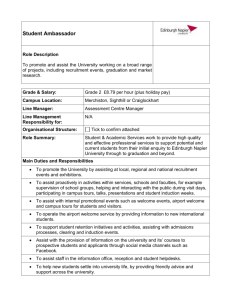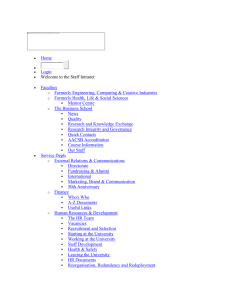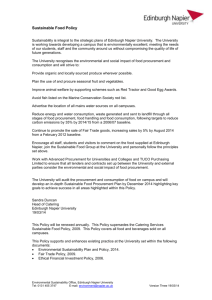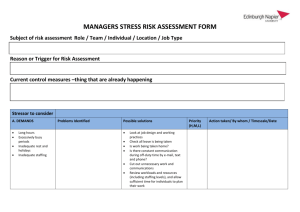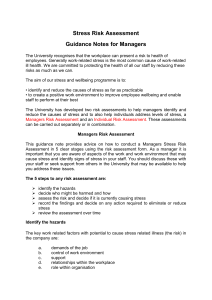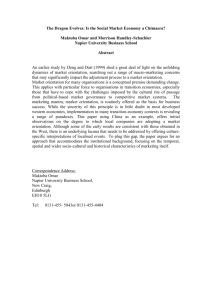IT Strategy - Edinburgh Napier University
advertisement
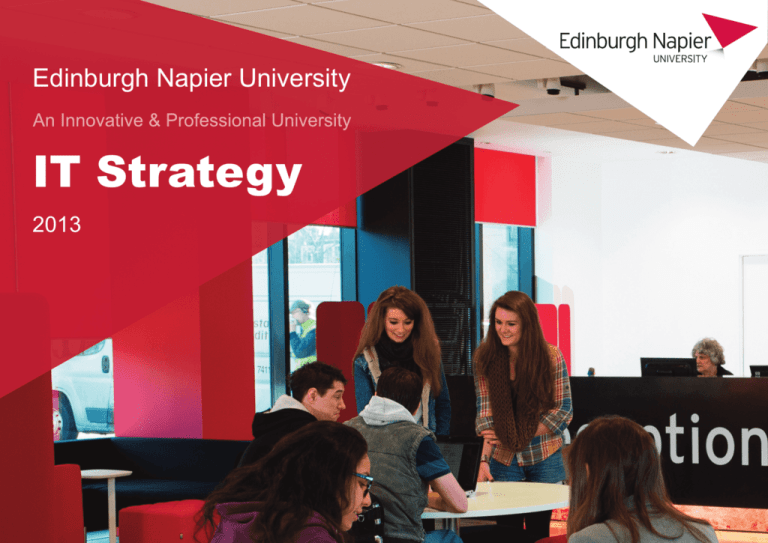
Edinburgh Napier University IT Strategy 2013 Contents Aim 3 Our Vision 4 What our customers are saying 6 Introduction 5 The Story so far 7 IT Strategic Themes 9 Our Strategic Priorities Delivering the Strategic Themes 1: Teaching, Learning and Research 2: Business 3: Student Experience The Risks to the Strategy What We need 8 10 10 11 12 13 14 Edinburgh Napier University IT Strategy 2013 2 Aim The aim of Edinburgh Napier University’s Information Technology (IT) Strategy is to establish priorities for the future development of, and investment in, an information technology-based environment which will support the learning, teaching, research and business needs of the University and all its members. “Keep going - asking us the users and listening to our feedback ” 3 Edinburgh Napier University IT Strategy 2013 “You should keep… ” up-to-date with technology “Easy access and easy to use ” Our Vision The IT Strategy will create an environment that provides the means to: _ use innovative technologies to enhance and improve the delivery of teaching and the learning experience of our students _ support research _ create effective and efficient business systems and processes _ communicate and collaborate with colleagues at anytime and anywhere in the world _ operate in a well-supported and secure environment Edinburgh Napier University IT Strategy 2013 4 Introduction Edinburgh Napier University has been successful over a number of years in centralising, consolidating and designing its IT infrastructure, systems and services to be resilient, efficient and cost effective. Our IT deployment is seen within the sector as progressive and effective at implementing cutting edge technologies, yet avoiding the pitfalls of being at the ‘bleeding edge’. The sector has, however, seen significant impact of changes across the UK including the adoption of different models for funding and the considerable pace of technological change driven by the consumerisation of IT. Add to this the McClelland and Diamond reports here in Scotland and “Students at the Heart of the System” south of the border. We have seen considerable government intervention not only in funding but also the operating models and the impact on the governance and administration of our Universities. The use of technology has also changed at considerable pace with the emergence of Bring Your Own Device (BYOD), Social Media, Software as a consumable item and Massive Open Online Courses (MOOCS) which are often demand led and out with the control of IT. Despite this pace of change there are consistent and recognisable areas of business function for Universities: _ Learning, Teaching and Assessment _ Research _ Commercial activity _ _ 5 Administration Internationalisation Edinburgh Napier University IT Strategy 2013 IT systems enable all of these functions to operate under ever-evolving business processes, transactions and engagement with staff, students and partners on everything academic, social and business. IT departments therefore have a critical role in the operation and future aspirations of all areas of the University. A University IT Strategy is considered essential in order to highlight why and where investment is required in IT infrastructure and services that will impact all areas of the University. Adapted from UCISA, Strategic challenges for IT services, 2013 “Fees online - as currently need to go to a campus to show face ” “Online Exams” “Moodle very good ” especially for catch up and podcasting What our customers are saying For some time, Edinburgh Napier University’s IT has performed well in student and staff surveys, consistently out-performing many other areas. Our customers are as diverse as the systems that are needed to support them. In order to sustain and further improve IT’s rankings in national and local surveys, Information Services understands how important it is to listen to our customers’ views and act on their requirements and concerns. At the heart of this Strategy development is a wide ranging consultation that took place in order to seek the views of all our stakeholders and this has informed the key themes of this Strategy. We interviewed over 80 students on all campuses to seek their opinion directly as well as including feedback contained in the Student Closeness Survey. Academics, Senior Academics and Professional Services staff have all contributed to, and therefore informed, the strategic themes discussed here in this Strategy. The overwhelming response from staff and students was positive about all aspects of IT provision at Edinburgh Napier. A number of themes emerged which, not unsurprisingly, reflected the changing environment both staff and students find themselves operating and learning in. Our customers are rightly unconcerned about the technologies that underpin their requirements. Therefore this Strategy leads from their perspective then links to the necessary short form descriptions of requirements that results in an action plan that relates directly to the projects, systems and services required to deliver them. Key messages were: “Accessible, interactive, good response time, friendly for us who are not wonderfully IT literate “A place where I can do all my work and find the things I need ” “You should keep… ” up-to-date with technology ” “I work from home, access to all the IT services is really helpful ” “Easy access ” and easy to use “Keep going - asking us the users and listening to our feedback ” “Technology in group study rooms is a good idea but need more of it for collaborative working ” Edinburgh Napier University IT Strategy 2013 6 The Story so far Edinburgh Napier University operates a highly resilient, recoverable and efficient core infrastructure consisting of multi-campus wired and wireless networking, geo-dispersed storage, virtualised server hardware and enterprise class information systems. Fundamental to the design approach is operating efficiency through shared multi-use, available ondemand processing and network storage defined as the University’s Enterprise Architecture. This infrastructure is partially extended into the Cloud and delivers a wide range of applications and services to all members of the University. The service is currently supported by a recently restructured Technical Services Team within Information Services with wide ranging professional IT service development and management skills. The total cost of operating this service currently runs at approximately 25% below average sector IT spend (Gartner metrics 2011/12, 2012/13). The enterprise class applications, infrastructure and services are supported by Programme and Project Management, utilising business process and systems analysts’ expertise to improve information systems and services. This service further supports Faculties, Professional Services and Institutes to access Information Services’ business innovation, information and process improvement capabilities. 7 Edinburgh Napier University IT Strategy 2013 “ There should be interactive support for if you are working on campus ” “Better communication of what they offer ” “More designated areas for laptop use ” Our Strategic Priorities The current services and infrastructure are well placed to support the strategic objectives of the University and its current priorities. However, the IT Strategy must address the evolving environment in response to our customers’ needs and the changing social, political and economic environment. The themes therefore focus on delivering what all our customers require by building on our capability and extending it to: _ _ _ Support our students in all their learning and research activity Support established teaching methods and pedagogic innovation Improve information quality _ Improve information as the life blood of the organisation _ _ computers with small study areas. Fast computers ” “yes - better sync between home and university technology ” Support wider more accessible collaborative working _ _ “lots of available Improve IT accessibility Support the creation of cross-University operating efficiencies and business process improvement Lead and contribute in our area of expertise to the wider Digital agenda of the University The strategic priorities are derived from the analysis of our information gathering and we have created a strategy for IT that focuses on the needs of Academic and Professional Services, and the needs of our students as stated by them in their own words. Edinburgh Napier University IT Strategy 2013 8 IT Strategic Themes 1: Teaching, Learning and Research Supporting staff, students and researchers in leveraging technology to improve learning and teaching Aims 1.1: To support collaboration and innovative teaching methodologies through investment in technologies to improve teaching and learning spaces. 1.2: To widen the provision and accessibility of digital materials and hence support academic learning through improved search, referencing tools and course related content. 1.3: To establish Moodle as the primary source of all learning materials and learning objects accessible to all students regardless of time and location. 1.4: To better integrate the range of technologies into a virtual learning suite that is simple to use, personalised and which supports the facilitation of learning. 1.5: To improve Information Services’ support of the learning experience by assisting our Academic colleagues to leverage existing and emerging technologies and promoting digital literacy in support of learning. 1.6: To build on and improve existing Faculty support for international activity through sharing current knowledge, expertise, best practice and learning gained from prior International experiences. 1.7: To blend a range of technologies that support improvements in assessment feedback, research development and widening participation in partnership with local and international staff. 9 Edinburgh Napier University IT Strategy 2013 2: Business Modernising the University’s business systems and services, creating efficiencies and supporting improved and diverse operating models Aims 2.1: To build on the progress made with the University information architecture to improve data quality across all primary business systems. 2.2: To ensure the integrity, compliance and availability of the University’s key business systems defined as: the Student Records System, the Finance System, the Estates System, the HR System, the Virtual Learning Environment, the MIS services and Online Communication and Collaborative Technologies. Working in partnership with System Sponsors, Business Owners and Systems Managers to ensure our systems’ fitness for purpose. To continually improve agility and integration to support all aspects of the University’s business. To continue to work with our auditors and security specialists to ensure our systems are the single source of accurate, timely and secure information. 2.3: To establish a process of portfolio management to assess, review, manage and consolidate the current University business and academic systems. 2.4: To expand and integrate our current infrastructure, systems and services into the cloud to increase capacity to respond to operational demand and take advantage of cost efficiencies and improved operating models that this brings. 2.5: To support international activity by utilising our knowledge of IT contract and vendor management, global use of technology and our experience working as a preferred partner both internally and externally. 2.6: To simplify and communicate the role of IT Governance in the business of the University providing advice on information security and safe data management. 2.7: To establish an Edinburgh Napier University Enterprise Architecture to create a unified enterprise-wide environment and experience in which the core hardware and software systems are standard and integrated across the University and its business processes, thus enhancing competitive advantage and innovation. 3: Student Experience Positively impacting the student experience through technology and embracing the consumerisation of IT Aims 3.1: To improve social spaces by providing easy, convenient access to IT and through welcoming users’ own devices. 3.2: To enhance the current student portfolio, underpinned by the Student Portal and Virtual Learning Environment, to ensure personalised ease of use and accessibility anywhere, anytime. 3.3: To support our students with a range of interactive personalised, on demand friendly support 24 hours a day 7 days a week. 3.4: To take every opportunity to make available student services and resources online and improve upon the current experience of home, campus and internationally based working and research. 3.5: To simplify and organise all IT support materials making them timely, relevant and accessible to support student engagement and get benefit from all available technologies, software and services offered by the University. 3.6: To integrate the use of social media into supporting our students, collaborating with them on the development of IT and digital resources to ensure they understand the benefit and value of our services to them. 3.7: To diversify the devices available in all learning environments to ensure necessary access to the right device, with the right software and services at the right time for students in a range of disciplines. Delivering the Strategic Themes 1: Teaching, Learning and Research We will support staff, students and researchers in leveraging technology to improve teaching, learning and assessment by: 1.1: To support collaboration and innovative teaching methodologies through investment in technologies to improve teaching & learning spaces. 1.2: To widen the provision and accessibility of digital materials and hence support academic learning through improved search, referencing tools and course related content. 1.3: To establish Moodle as the primary source of all learning materials and learning objects accessible to all students regardless of time and location. 1.4: To better integrate the range of learning software by creating a virtual learning suite that is simple to access, navigate and personalise. 1.5: To improve Information Services’ support of the learning experience by assisting our academic colleagues to leverage existing and emerging technologies and promoting digital literacy in support of learning. 1.6: To build on and improve existing faculty support for international activity through sharing current knowledge, expertise, best practice and learning gained from prior International experiences. 1.7: To blend a range of technologies that support improvements in assessment feedback, student engagement and widening participation in partnership with local and international staff. Investing in device availability and management: that enables the learning experience to be conducted in a joined up and integrated way that is easy to use and supports the collaborative nature today’s students expect. For example by linking networked smart boards, interactive tables, interactive information points, integrated conference cameras, lecture capture, multi device connectivity and audio access points. Providing access to learning and productivity software and tools on any device: through the development and implementation of a full service Virtual desktop delivering the latest University desktop and networked applications on and off campus, to any device. And developing Mobile applications suitable for use on a range of devices that bring key services to the users smart phones and tablets. Extending extensively the functionality of a fully integrated SharePoint and Moodle service: bringing together a single source of all learning materials, communications, storage and learning related activity such as ‘Live chat’, podcasts, voting, academic progress tools, eResource search functions and the recording of student engagement. Establishing and implementing an Information Services team: specifically to strengthen relationships with academic colleagues. This will create an environment where we can transfer knowledge, gather new innovative requirements, share expertise and development objectives all working collaboratively to enhance the student learning experience. To be academically excellent To develop confident employable graduates To be an international university To be a preferred partner “Yes, utilises resources - Moodle mainly. Online Lectures would be useful ” Edinburgh Napier University IT Strategy 2013 10 2: Business Modernising the University’s business systems and services, creating efficiencies and supporting improved and diverse operating models by: 2.1: To build on the progress made with the University information architecture to improve data quality across all primary business systems. 2.2: To ensure the integrity, compliance and availability of the University’s key business systems defined as: the Student Records System, the Finance System, the Estates System, the HR System, the Virtual Learning Environment, the MIS services and Online Communication and Collaborative Technologies. Working in partnership with System Sponsors, Business Owners and Systems Managers to ensure our systems’ fitness for purpose. To continually improve agility and integration to support all aspects of the University’s business. To continue to work with our auditors and security specialists to ensure our systems are the single source of accurate, timely and secure information. 2.3: To establish a process of portfolio management to assess, review, manage and consolidate the current University business and academic systems. 2.4: To expand and integrate our current infrastructure, systems and services into the cloud to increase capacity to respond to operational demand and take advantage of cost efficiencies and improved operating models that this brings. 2.5: To support international activity by utilising our knowledge of IT contract and vendor management, global use of technology and our experience working as a preferred partner both internally and externally. 2.6: To simplify and communicate the role of IT Governance in the business of the University providing advice on information security and safe data management. 2.7: To establish an Edinburgh Napier University Enterprise Architecture to create a unified enterprise-wide environment and experience in which the core hardware and software systems are standard and integrated across the University and its business processes, thus enhancing competitive advantage and innovation. 11 Edinburgh Napier University IT Strategy 2013 Restructuring our physical infrastructure: to build integration with cloud based services ensuring the efficient sharing and expansion of our storage, applications and services in partnership with cloud vendors and services. To become a hybrid integrated secure and cloud service provider that balances business need with agility. Supporting a future Enterprise Architecture approach: through the adoption of Master Data Management to reduce duplication, standardise data and removing errors in data to improve quality and information as a service. Standardising the interfaces to systems and adopting further Service Orientated Architecture (SOA) approaches to improve business processes by providing access to multiple business systems through a single interface. Review current policies and contracts to support integration with cloud services and their on-going management and maintenance. Moving Services to the Cloud: where appropriate, moving existing large scale standard services to reduced cost cloud services such as Staff Email and Alumni & Development CRM. Reviewing and rationalising the Application Portfolio: in collaboration with University’s System Managers to create efficiencies and to conduct the necessary analysis to determine the metrics associated with applications and their cost of implementation, maintenance and support. To look for opportunities in cost effective sharing or partnering to share resource with or on behalf of other institutions. Continually investing in our Business Systems: to expand their support to the University, providing the agility to adopt new practices that simplifies and improves existing and emerging processes. To achieve the highest organisational standards To create, exploit and transfer knowledge To be a preferred partner “Online forms which then could be printed for signature instead of waiting for forms to be created and signed ” “better iphone access to ” Wi-Fi, more storage space 3: Student Experience Positively impacting the student experience through technology and embracing the consumerisation of IT by: 3.1: To improve social spaces by providing easy, convenient access to IT and through welcoming users’ own devices. 3.2: To enhance the current student portfolio, underpinned by the Student Portal and Virtual Learning Environment, to ensure personalised ease of use and accessibility anywhere, anytime. 3.3: To support our students with a range of interactive personalised, on demand friendly support 24 hours a day 7 days a week. 3.4: To take every opportunity to make available student services and resources online and improve upon the current experience of home, campus and internationally based working and research. 3.5: To simplify and organise all IT support materials making them timely, relevant and accessible to support student engagement and get benefit from all available technologies, software and services offered by the University. 3.6: To integrate the use of social media into supporting our students, collaborating with them on the development of IT and digital resources to ensure they understand the benefit and value of our services to them. 3.7: To diversify the devices available in all learning environments to ensure necessary access to the right device, with the right software and services at the right time for students in a range of disciplines. “Time with someone to show how to do stuff proactive ” Making IT more open and accessible to all: by investing in the pervasiveness of WiFi at and near campuses with simplified access and support. Working with Sector partners to provide WiFi coverage across Edinburgh. Implementing Mobile Device Management to improve the service to staff and student mobile and smart devices. Enhancing mobile compatibility for SharePoint, Moodle and support services in line with Email and existing App based provision. Enhancing the staff/student social spaces to accommodate collaborative working by making available selfservice Laptop/Mac and Tablet devices, Digital signage, Digital information points, Charging stations and touch screen multi user devices. Social integration: Developing and implementing peer based collaboration tools that are integrated with social media and managed by students themselves. Developing a social networking technology support service for IT targeting key areas of support critical to key dates in our academic calendar and easily accessible by our students and staff. Improving access to knowledge: Developing and implementing an interactive knowledge base with information, video and audio podcasts to support the use of technologies on and off campus. Making it easier to work and collaborate: through the development and implementation of a ‘profile anywhere’ approach to Identity Management that supports working across devices, campuses and internationally where devices become a gateway to individuals and/or groups’ information and services. Further integrating this profile with mobile services that reliably connect to multi-functional devices (MFD) for printing scanning and copying and other end user support services. To develop confident employable graduates To be an international university “Tablets and pcs for free use in social space and surface tablets plus interactive tables and large collaboration space ” Edinburgh Napier University IT Strategy 2013 12 The Risks to the Strategy Medium Mitigation: Ensure that policies and controls are in place to govern the use of University’s and students’ devices Mitigation: Establish control and policies as to access and visibility of the data/services held in the Cloud. Mitigation: Clear and effective communication of the IT Strategy along with its requirements and benefits to the University Low Impact High Mitigation: Establish a cross University Information Security Board to ensure that best and most up-to-date practice is communicated and embedded into the University’s business Low Medium Likelihood High Mitigation: Periodic review of IT Strategy will allow internal and external factors to be assessed along with their impact Mitigation: Work with relevant University Staff to identify business procedures and policies which either require updating or creation. Review and upgrade IT Governance. Mitigation: Identify the necessary skills to undertake project tasks and ensure that relevant training is given to the right personnel Mitigation: Communicate effectively the benefits of all Technical Services work University wide 13 Edinburgh Napier University IT Strategy 2013 What We need ISDC An approved 3 year capital investment plan Agreement and commitment to the IT Strategy Deans Early involvement in new business plans Early involvement in proposed International activities Finance Assistance with benefit realisation activities, Assistance with cost metrics and efficiency measures Holding sponsors accountable for non-IT activities, and promised benefits Business Units Active participation in shared-service planning Active involvement in ITT, funding bids and business development planning Commitment to the System Managers’ Group and it’s objectives Commitment to working with data quality, information architecture and business process improvement techniques Procurement Cloud procurement models available Capital investment versus long term agreement rentals and contracts Students Continually providing feedback on IT Providing input to developments and contributing to projects and service development “collaborative ” rooms with technology “Charging points, bus tracker and more social space information ” Edinburgh Napier University IT Strategy 2013 14 15 Edinburgh Napier University IT Strategy 2013 Edinburgh Napier University is a registered Scottish charity. Reg. No. SC018373

